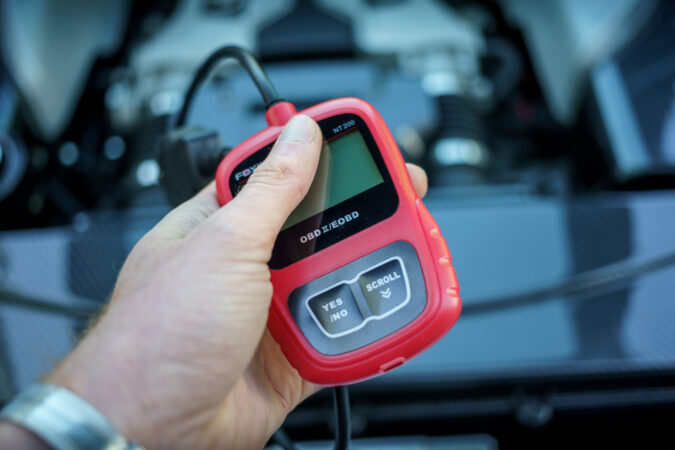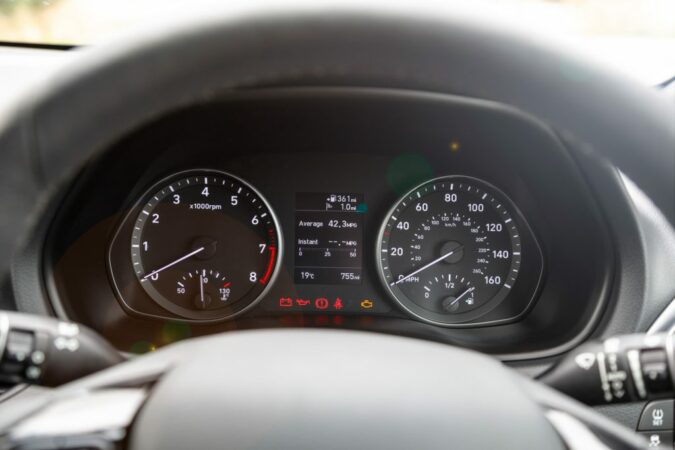Having engine power reduced Chevy Silverado can be both irritating and worrying. So how do you resolve this issue? Here are some of the most typical causes.
A faulty throttle position sensor is the most frequent cause of diminished power in your Chevy Silverado. To resolve this problem, new connectors, wire harnesses, and sensors will need to be installed.
Your Chevy Silverado has fewer engine issues for a number of reasons. Continue reading for answers to more frequently asked questions regarding the Chevy Silverado.
Engine Power Reduced
The engine power reduced Chevy Silverado power light will turn on whenever the vehicle’s computer detects an issue with the components that make sure that the engine will run smoothly, which includes the throttle sensors, oxygen sensors, as well as airflow sensors.
The light will not always be present in the car that does have this warning system, nor is it present in all of them.
If your car has a screen in the gauge cluster, it might in some cases be a warning that is shown there.
This light is typically found on General Motors cars.
If your vehicle gets in “limp mode,” as shown above, it will be pretty clear, especially if the check engine light remains on and it has significantly reduced power and functionality.
The low engine power light may illuminate for a number of causes, all of which should raise suspicion.
Using a high-quality scan tool should make it quite simple to determine the exact source of the problem after scanning your car.
Engine Power Reduced Chevy Silverado, Causes #1 – A Loose Wire, Clamp, Or Harness
There are numerous wires and connectors within your car that keep everything powered and functional. Your car may experience a problem due to an electrical short, a loose ground wire, or a loose clamp.
Should it happen, this is probably the most straightforward and obvious problem. You’ll almost certainly need to speak with a qualified mechanic if, however, there are no loose parts, no exposed or faulty wires, and everything has a good connection.
How To Fix
Always unplug the batteries before tinkering with wires or sensors while working with a car’s electrical systems.
Ensure that every connection is secure. Look for frayed or loose grounds or frayed or loose wires. Keep an eye out for frayed or exposed wiring.
Most loose connections can simply be reconnected, but any exposed or damaged wiring needs replacing.
Engine Power Reduced Chevy Silverado, Causes #2 – Oxygen Sensors Are Failing
The amount of oxygen leaving the car through the exhaust system is measured using oxygen sensors.
They help to alter the air-fuel ratio for efficient combustion. The check engine light or low engine power light will come on if one is faulty.
How To Fix
Your oxygen sensor may need replacing, but you can try cleaning it at the very least.
The majority of contemporary cars include at least two oxygen sensors, one before and one after the catalytic converter, while some can have as many as eight. You must determine which sensor is throwing the error using an OBD II scanner.
Replacement oxygen sensors don’t cost a lot—up to $500—but for most of them, a specialized instrument is needed to accomplish the task. Most individuals don’t have this tool, which is simply a specialized diagnostics scanner and is relatively inexpensive.
You have two options: try to clean your oxygen sensor yourself, or buy a replacement online and have a mechanic install it. The cost of replacement will be reduced, at least somewhat.
Engine Power Reduced Chevy Silverado, Causes #3 – Faulty Throttle Position Sensor
The butterfly valve that opens to let air into the engine is often close to the throttle position sensor inside the throttle body.
The computer uses this sensor to determine how much to open the valve and release a corresponding amount of air into the engine based on the location of the accelerator pedal as you press the gas pedal.
As air enters the engine, this sensor also assists with transmission shifting. The car will enter limp mode and turn on the decreased engine power light if this sensor can’t interact with the computer systems in order to control engine revving.
How To Fix
Similar to the oxygen sensor, replacing the throttle body sensor is neither an enormously expensive nor a particularly cheap remedy. Depending on the make and model of your vehicle, a replacement sensor can cost anywhere from $100 to $500.
Although a skilled DIYer should be able to change it themselves, it’s more likely that a mechanic will need to replace the sensor and maybe the complete throttle body.
You can at the very least purchase a replacement sensor to prevent any price gouging from happening.
Engine Power Reduced Chevy Silverado, Causes #4 – Throttle Body Problem
The throttle position sensor is only one component of the throttle body.
Within the throttle body, a butterfly valve opens and shuts to let air into the engine. This valve’s damage or breakage could cause the engine power reduced Chevy Silverado power light to come on.
Additionally, carbon buildup inside the engine could obstruct the opening of the valve, tricking the engine into thinking it is receiving less air, which would reduce power and activate the warning light.
How To Fix
In general, it’s simpler to replace the throttle body as a whole than to repair each component separately. Before labor, the majority of replacement throttle bodies can run you between $100 and $200.
However, you might not need to swap out the throttle body. Try cleaning it yourself first before spending any money on it. It is simple to fix air restrictions caused by dirt and soot.
Even if the throttle body needs replacing, the procedure is simple and quick.
Engine Power Reduced Chevy Silverado, Causes #5 – Mass Airflow Sensor Is Defective
Between the air filter and the intake manifold is where you’ll find the mass airflow sensor.
It provides the computer with instructions on how to deliver and mix the fuel with the incoming air to ensure optimal combustion inside the engine by measuring things like air density and pressure entering a direct injection engine.
How To Fix
Like the throttle body, you can clean the mass airflow sensor of any dirt that can build up due to a misaligned or obstructed air filter. These days, they even produce sprays that help to clean the MAF.
A replacement can cost up to a few hundred dollars but typically falls in line with the price of an oxygen sensor or throttle body.
Additionally, it is not necessary to hire an expert to work on this for you. Making the replacement yourself is not too difficult, especially with all the charts and instructional videos that are now readily available online.
Engine Power Reduced Chevy Silverado, Causes #6 – The Car’s ECU Is Broken
The computer that all of these sensors communicate with is the ECU, or engine control unit. It manages virtually every aspect of a car’s operation and even tries to account for odd circumstances introduced within the engine.
One of the most serious and expensive problems that can turn on the engine power reduced Chevy Silverado power light is a malfunctioning ECU.
How To Fix
Unfortunately, since the ECU is essentially a computer, utilizing an OBD II scanner to do a scan is the only reliable way to determine if it is the source of the warning light.
A replacement ECU is available for purchase, but it might need tuning or re-flashed in order to effectively react to the particular vehicle and ambient circumstances.
Unless you are confident in your own computer and tuning capabilities, it is advisable to have a professional mechanic handle this.
Engine Power Reduced Chevy Silverado, Causes #7 – It Has Clogged Catalytic Converters
After the exhaust manifold, the catalytic converter is set underneath the car. Its role is to reduce hazardous emissions by oxidizing and converting carbon monoxide into carbon dioxide.
Cars without catalytic converters are currently not permissible on the roads (unless they are pre-1975 models), and they will fail an emissions test if there is a blockage.
Although the check engine light is more likely to come on, the decreased engine power warning light can also flash.
How To Fix
Because of the materials utilized and design, replacing a catalytic converter is an expensive repair, similar to replacing the ECU. With labor, a new one may cost more than $2000.
Though a tech-savvy DIYer can easily change the catalytic converter on their own, they will still want a jack stand and other tools because the repair requires getting under the car.
Engine Power Reduced Chevy Silverado, Causes #8 – Batteries Are Having Issues
Most of the time, a dead/damaged cell in the battery or a loose ground won’t result in the engine power reduced Chevy Silverado power light turning on.
Before a warning light turns on, a battery problem will probably present with additional symptoms.
How To Fix
Making sure all the connections are in place and don’t rust is the most straightforward approach to resolving a battery problem.
By disconnecting any cables and using baking soda or another cleaning to get rid of the unwanted buildup, you can quickly clear off any corrosion surrounding the terminals.
The electronics, or lack thereof, as well as the inability to start your car, will likely alert you to a problem earlier than a warning light will. This is especially true if battery cells are faulty or dead.
Replacement batteries are frequently changed and are typically not very expensive.
Though it’s possible that simply charging your battery will do. Utilizing a specialized battery tester and analyzer with diagnostic tools will provide you with the only accurate assessment of your battery’s condition.
If you decide you need a new battery, make sure you obtain the proper one by reading our guide on car battery kinds, groups, and sizes!
Engine Power Reduced Chevy Silverado, Causes #9 – There Is A Transmission Fault
A gearbox error code is another problem that will most likely set off the check engine light before the low engine power light.
Since every sensor discussed so far in this article is crucial to proper transmission operation, decreased engine power could result from the transmission or any one of its components.
A slipping clutch or low transmission fluid could both set off a problem code.
How To fix
By consulting your owner’s manual or using our instructions on how to check and add transmission fluid, you can check the fluid yourself.
In essence, you locate the dipstick and assess the quantity and caliber of the fluid. Similar to checking the engine’s oil, then.
Sometimes changing the transmission fluid will remedy the problem, but this is uncommon because there is typically a more serious problem present.
It will be possible to get more specific information about any transmission defects by running a scan on the vehicle.
P1516
The method your car lets you know anything is wrong is through error codes. Diagnostic codes like P1516 have multiple meanings, and there are various codes for common problems and manufacturer-specific faults.
Therefore, it would be advisable to have a fundamental understanding of the code and how to determine the issue from the symptoms.
Every day, you drive to work. Suddenly, you sense that there is less power. The vehicle does not accelerate past a certain speed, even when you are revving it up.
The problem code P1516 appears, and the Check Engine light comes on. You may read more about the P1516 engine code’s definition, symptoms, causes, and solutions here.
1. Understanding Code P1516
Basically, OBD code P1516 indicates that the Throttle Actuator Control (TAC) system is having issues.
Because the Engine Control Module (ECM) attempts to prevent a failure by keeping you from driving for an extended period of time, the vehicle won’t be moving at a speed above a certain level.
an error code P1516 is a diagnostic error code unique to the manufacturer. Models from General Motors, including Buick, GMC, Saturn, Hummer, etc., utilize this code.
Consequently, the definition of the P1516 engine code in a GM vehicle will differ from that in an Audi or a Hyundai.
2. What Does The Code P1516 Indicate
Throttle Actuator Control Module / Throttle Actuator Position Performance, OBDII Code P1516
The ECM is responsible for controlling the Throttle Actuator Control (TAC) system. Both of these parts transmit the information as voltages.
The ECM’s responsibility is to estimate the throttle response and ascertain the driver’s intention. You will require a throttle body, which transmits a voltage with a modulated pulse width, for this calculation.
To keep track of the TAC data, the EDM contains two processors. The P1516 engine code will be shown if the actual throttle position differs from the anticipated throttle position for longer than 0.5 seconds.
3. What Signs Could This Code Indicate
Common indications of this code include:
- check Engine light comes on
- unresponsive throttle
- the car cannot accelerate
- low fuel efficiency
- during idling, the engine maintains a fixed speed
- the car occasionally bucking and surging
4. What Triggers The OBD Code P1516
This code could be caused by a variety of circumstances, such as:
- a defective TAC module
- an inoperative pedal position sensor
- leakage of water into the TAC module connector
- wiring issues with the TAC circuit
- damaged or bent throttle body
- the TAC module harness is damaged or open.
5. What Causes This Error Code
As you have already seen, based on the model, the code’s definition and description may change. So check to see if the manufacturer has published any fresh updates before you start diagnosing.
The code will disappear after you are done with the upgrades.
Verifying whether there are any further active fault codes is the next step. If so, address them first before moving on to the P1516 error code.
If a technician needs to check for the problem, they will determine what is triggering the code and find the precise issue by looking at the ECM. Here are a few methods for diagnosing the P1516 GM engine code.
Check the Throttle Body Engine Control and Throttle Body Motor Control circuits for issues when inspecting the TAC Module.
Throttle Actuator Position Sensor (TAPS) Inspection The condition of connectors and wiring can be determined through a comprehensive visual check.
You may need to replace the sensor if the cabling is faulty, there are bare wires, or damaged insulation is touching the frame.
Check the throttle plate to make sure it can move freely and that no obstacles are in its path. The issue code P1516 may also have this as a cause if it is not.
TAPS voltages: While operating the car, you can scan the TAPS voltage signals. This can make it easier to find the issue if the values are inconsistent.
6. Fixing Code P1516
One or more of the following fixes can be used when a correct diagnosis has been made.
- Swapping out the TAC module.
- TAC module harness can be fixed or completely replaced.
- Replace or fix the faulty throttle body.
- Make sure there is no water in the TAC module connector.
- The TAC circuit’s electrical connections should be repaired or replaced.
Losing Power While Driving
A car may experience power loss while in motion for a variety of causes. Here is a list of the most frequent offenders.
Are you experiencing power loss while driving?
There are a variety of possible reasons why your automobile can lose power while you’re driving. A car has to control the proper flow of air, fuel, and compression in order to run smoothly.
A large loss of horsepower could be due to any disruption to this procedure. There are several issues that could negatively affect your power. But there are certain factors that may be making your travels more difficult.
1. Clogged Fuel Filter
When you press the accelerator and don’t feel the expected response, there can be an issue with the fuel system. A clogged fuel filter is the likely culprit.
The fuel filter’s job is to keep dirt and debris out of the fuel system, eventually needing cleaning or changing.
The fuel pump has to work much harder when there is a blocking of the fuel filter. This makes the vehicle much less efficient. This means that if you try to accelerate while passing or climbing a hill, you won’t have the power you require.
The most frequent and simplest fuel system issue is the fuel filter, although problems with the fuel line or the fuel pump could also be to blame for a lack of power.
2. Issues With The Fuel Injector
The car may have trouble achieving high revs if there is blocking or a leak in the fuel injectors. Gasoline injector troubles are frequently accompanied by other concerns, such as ignition problems, misfiring, and even an increased fuel odor around the vehicle.
3. Power Consumption Of Air Conditioner
It’s critical to realize that your air conditioning uses some of the engine power if your automobile struggles to maintain power in hot weather.
So, if you have a lengthy drive ahead of you on a very hot day, you could notice that your automobile doesn’t seem to have the pull it usually has.
4. Check Engine Light Is Illuminated
When the engine warning light is illuminated, there is a serious issue with your car that needs the attention of an experienced repair. In order to assure safe driving and prevent accidents, many modern cars contain engine management units that will automatically put the vehicle into limp mode when a fault is detected.
Regardless, you should have the car evaluated because this false positive can indicate an issue with the electronics.
5. Issues With The Turbocharger
Engines are increasingly coming standard with turbochargers. These function by raising the air pressure during the combustion cycle, which enables the addition of more fuel and increases the amount of power produced by the cylinder explosions. Although turbos increase an engine’s efficiency, if something goes wrong, the engine will lose power.
Simple concerns like dirt or debris getting inside the turbo and messing with the operation could lead to problems.
Similar to this, even a tiny hole or loose tubing connection will have a significant impact on performance. For turbochargers to function properly, there is a need for oil, therefore keep the oil filter clean.
6. Excessively Hot Cooling System
In order to keep the engine running at a certain temperature, the cooling system comes into play. An overloaded heating system would force the cooling fan to work harder in extremely hot conditions, draining power from the engine and lowering performance levels.
If it’s chilly outside and the engine is overheating, there can be a more serious issue. Always keep an eye on the engine temperature. This is because running an engine that is too hot can seriously harm a car in the long term.
If the car is at a high altitude with thin air, it may also experience power loss from an overheated cooling system.
Frequently Asked Questions
What Does Engine Power Reduced Mean
The reduced engine power light indicates a problem that is reducing the air and/or fuel delivery in the engine. It often lights up when a vehicle needs repair or maintenance; it doesn’t necessarily indicate that your car is almost breaking down, but it might be due to an oil change.
What Causes Engine Power Reduced
Among the main causes are Issues leading to poor fuel pressure or volumes such as a faulty fuel pump and even a restricted fuel filter excess back pressure due to a catalytic converter or a limited exhaust. Inappropriate air/fuel ratio caused by sensor faults mass airflow sensor is often a major cause.
Can A Bad Battery Cause Reduced Engine Power
The fuel injectors may not be able to supply the cylinders with adequate gasoline if your battery is not operating properly. The performance of the car may suffer as a result. Computer: The electrical and mechanical systems of the car are put under additional stress by a poor battery.











